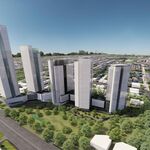fYeah, that's kind of the point. Do you really think that PRT will be drastically lower cost than subway? And when I say drastically lower cost, I mean half at the best. We're obviously not going to be building $300 million/km subway on Mavis, but will we be building $200 million/km PRT on Mavis for maybe half of the service? The problem is that basically what PRT is advocating is a car. So why don't we a) just funnel that money into a hydrogen/electric network, or b) just clear the roads and put in BRT or some other type of RT in the space that PRT would take up?
The point is that if you're
Alright. PRT won't cost $200 million/km. That's the point. The company that installed a pilot system at Heathrow has designed some systems for other cities as part of a RFP process, generally quoting $10 million/km in capital costs. To be fair, they have only built their Heathrow system, but if we guess they're off by a factor of two, then PRT is still far less than a tenth the cost of subway per installed km. Not that it is directly competing with subway. I'd say it is competing with suburban LRT/BRT/bus applications to a much greater extent. And I would certainly say that their system is only a baby step in terms of what PRT is capable of.
PRT is not a car. It's closest analogue is a taxi, with point to point service, low/no parking requirement, and a pool of vehicles shared by users.
As far as space utilization, PRT generally has to operate in a separate ROW. So when running along streets, it would generally need to be elevated. This is one strike against the system employed by Heathrow in my opinion: it's guideway would be a bit imposing for my taste. I'd lean more toward a suspended system, which has more flexibility. My point is, though, that the footprint would be supports every 20 or 30 m and stations.
So you've never seen two people meet by chance on the subway and discuss what's happening? Or at least enjoy other people's company as you take your trip home? Or perhaps have someone comment on your clothes or phone or something? I'll admit that part of that problem is the fact that we've got a broader social phenomenon coming from suburbanization and auto use that public transit won't solve as soon as you get on it.
I'm not saying this doesn't happen, I'm saying that it is rare. Furthermore, I'm not sure we should choose transportation options to optimize social interaction. I think sidewalks, stores, restaurants, pubs, cafes, bookstores generally serve this purpose pretty well.
Okay, so if public transit isn't as cost-effective as PRT, the only conclusion I can come to is that PRT will have a distance-based fee after you buy your $5k/year membership to pay for the cars that you use. That's really the only way for it to be actually cost effective, and it's the same deal you'd be getting using a car on a private toll highway.
No membership required. It would work just like a taxi. The operating cost would be lower than a taxi, since the vehicle would consume 75-90% less energy and would not require a driver. Also, travel times would be faster than taxi, especially in congested areas. As we know, people are pretty willing to pay high fares to use taxis, and PRT could provide taxi-like service at significantly lower cost. I think there would be a market, but it remains to be proven.
And you do realize that PRT would run on a pretty heavy subsidy too, just as cars do? I'm guessing that even a cost of maybe 50 cents/km and a $5k/year user fee could be optimistic for it to be totally on it's own, but would you really pay for that? Especially if you need a car anyways to get groceries or go up to your cottage? I honestly doubt it.
I would oppose large-scale PRT deployment if it required a subsidy, particularly if that subsidy is more per passenger kilometer than typical transit. I imagine that PRT would work quite well in conjunction with car-share programs. I think you're putting up a straw man with your $5k/year structure. No business would try to set up such a pricing structure. To give you an idea of what you're suggesting, if we had three million users paying what you suggest for access to this service, that would be equivalent to $45 billion per year, assuming 20,000 km per user which is typical for car use. Do you really imagine that a system would cost 45 times what it costs to run the TTC, just to serve the GTA? My point is that you're deliberately choosing absurd prices in order to conclude that no one would be willing to pay them. This is the straw man fallacy.
PRT just wouldn't work in a city situation. Even if you're going to be putting it on arterials, it's going to have a hard time keeping up with cars and the amount of traffic regular roads would be able to handle, and you'd still have to walk, drive, or take the bus to your local PRT station. And if you actually want it to replace cars, then you'll have to at least double track it on an arterial like Mavis. For that cost right there, you could probably stick a subway up Mavis instead.
I won't say to ban PRT from our transit toolbox, but just that if you were to try to fit it into almost any transit route, you'd find that there are much better options.
PRT doesn't have to stop between the origin and destination. Even if PRT has a lower top speed than cars are permitted, the fact that cars have to stop frequently significantly lowers their average speed. PRT generally emphasizes many, small stations to minimize walking. The key here is inexpensive stations where there is low demand. It is certainly conceivable to have a system where most homes and business are within a few hundred meters of a stop, which is only a few minutes walk. The walk is less of a disincentive if you don't have to wait for ten or fifteen minutes at the stop for a vehicle to arrive.
I'd agree with you, that if PRT cost $200 million/km it'd be a tough sell anywhere. Thankfully, the actual number seems to be closer to 1/20th that figure.
PRT isn't quite ready for prime-time yet, but I'm hopeful that the baby-steps it is currently undergoing can quickly spur more investment in developing the technology and larger deployments to build the case for its effectiveness.
If you're curious about some of the pitfalls and design problems with PRT, this blog is pretty interesting:
Open PRT Specification project It's written by an engineer trying to design a cost-effective, flexible, open-source PRT standard.




